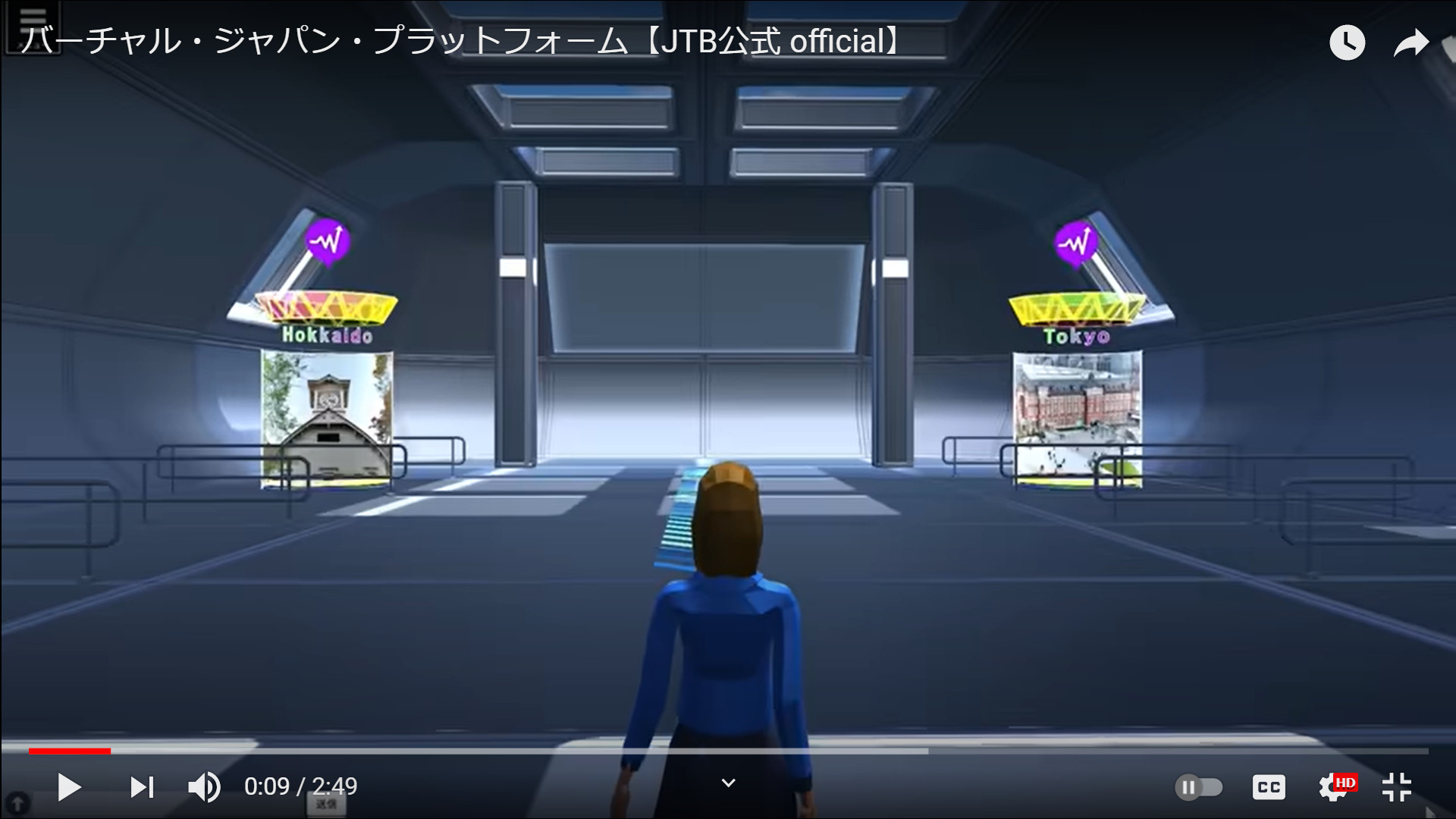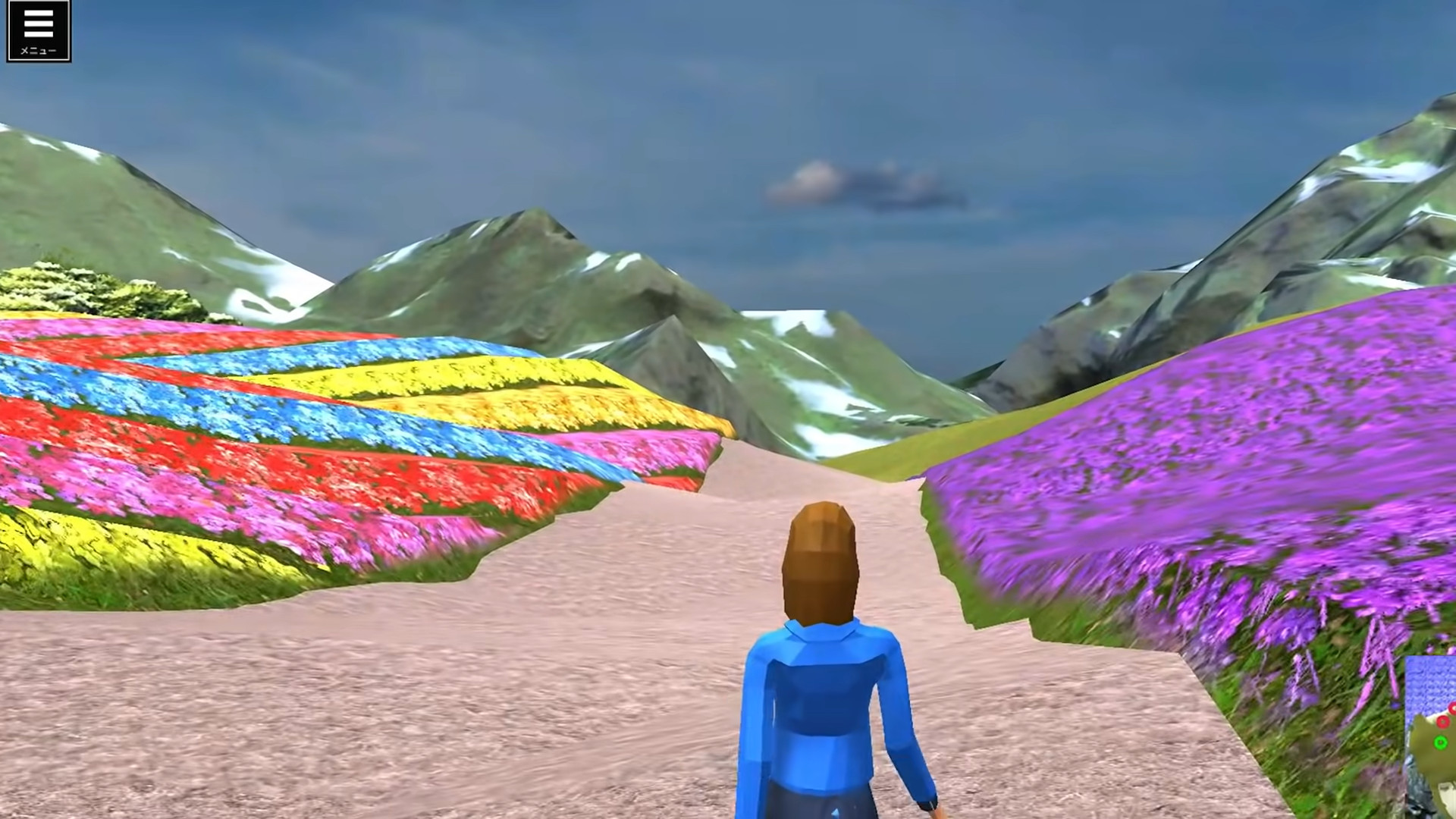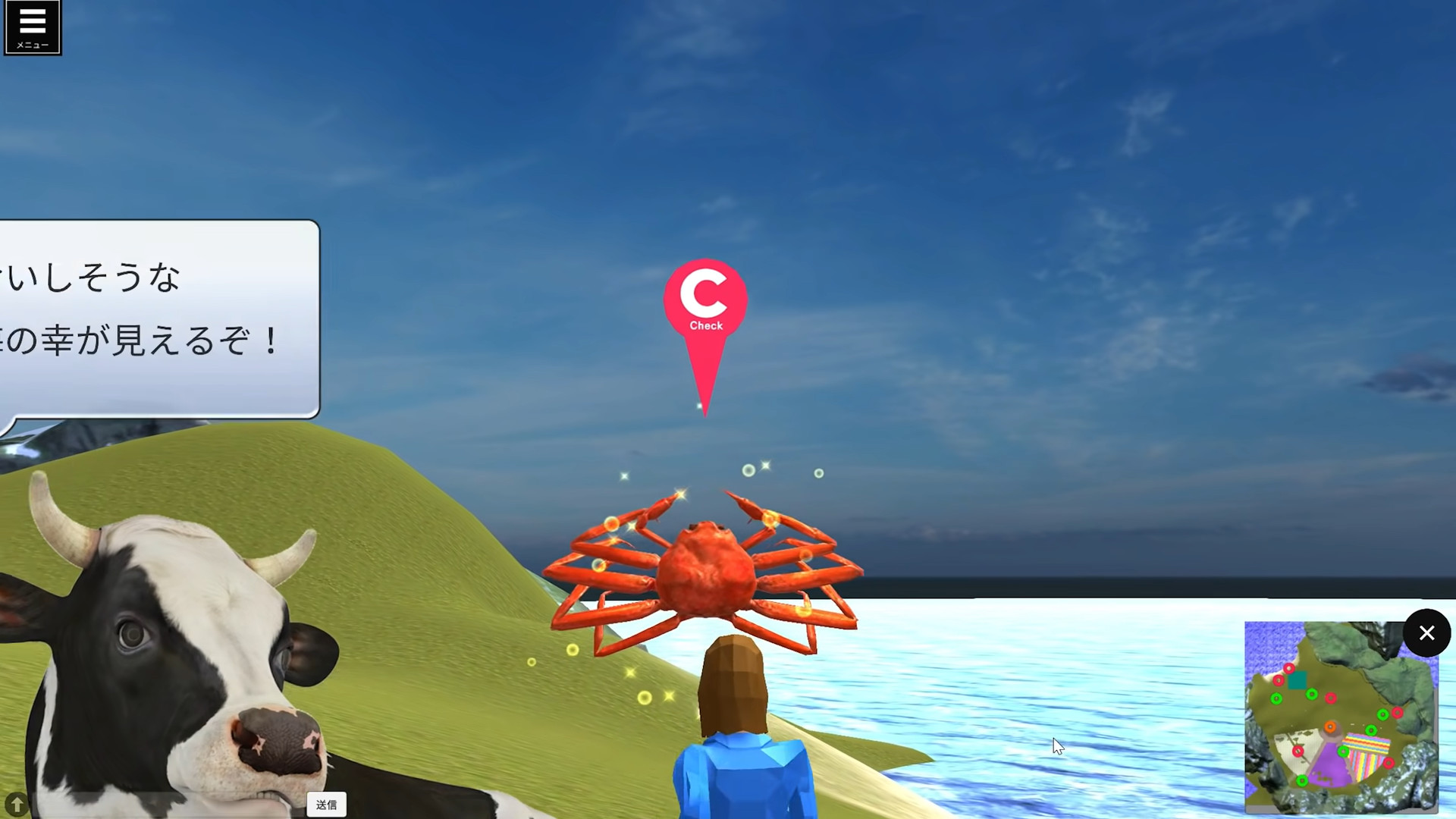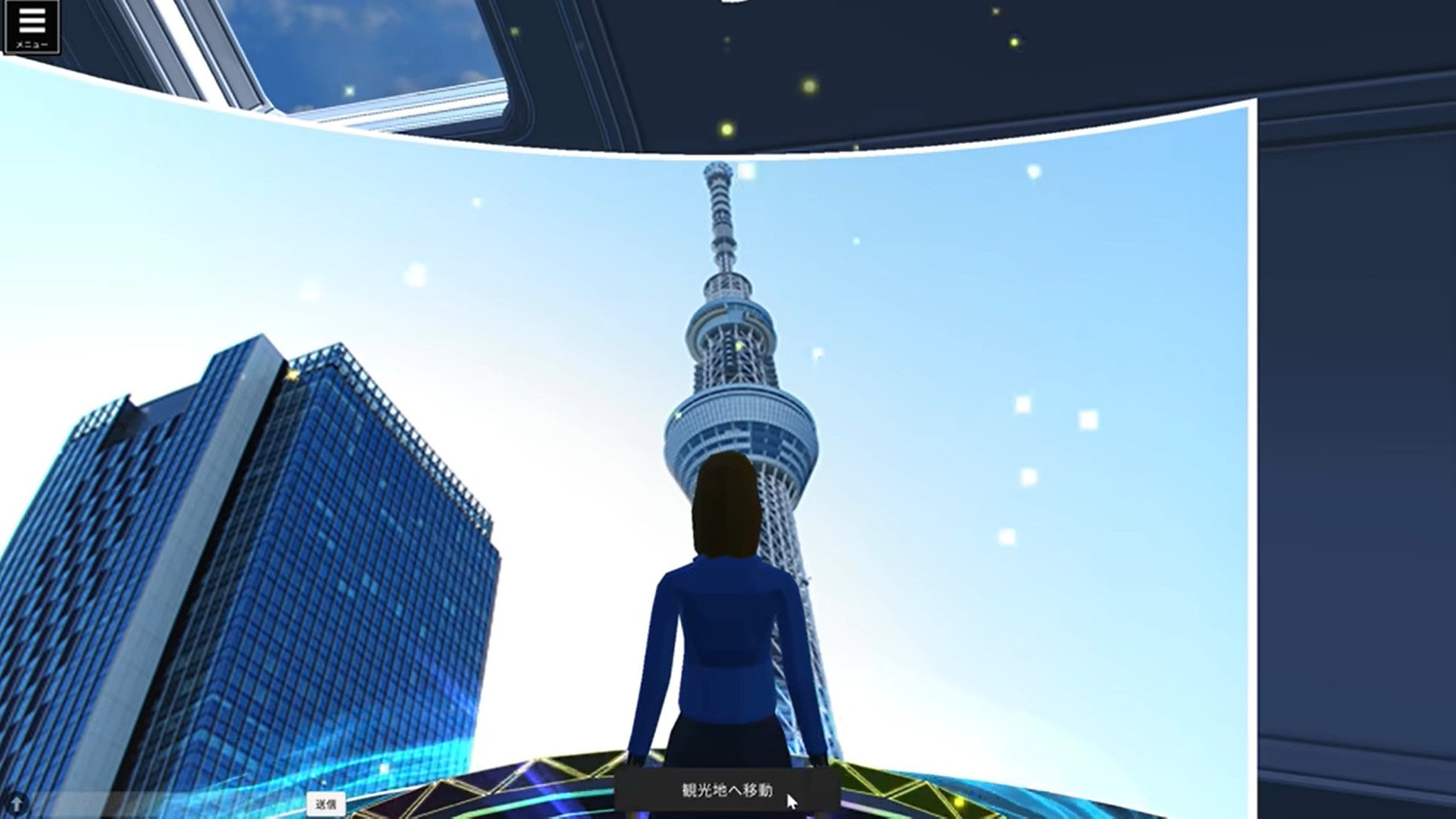
The concept is great, but the execution? Not so much.
These days we’ve come really far when it comes to the quality of CG in films and video games. With a nice fluidity of movement and smoothness of picture, many companies are able to use computer graphics to create beautiful, detailed scenes with a supremely realistic look that blends seamlessly with live-action shots, or in the case of video games, that immerse you in the game.
As a result, that level of quality of CG–or at least, something close to it–has pretty much become expected of most digital productions. So when this video of a new virtual tourism service created by travel company JTB and two other companies came out, people were blown away by just how utterly awful the graphics are.
For a program that is meant to convey the beauty of Japan to those living overseas, it sure doesn’t do a good job of it. Not only are the graphics flat, missing out on the exquisiteness of detail that comes with many game-like experiences these days, but the transitions and camera movements are blurry and hurt the eyes. From the few snapshots shared in the video, it looks like a video game you might have played on the computer circa 1997, or the type of graphics you might have seen on the Nintendo 64 a quarter of a century ago.
JTB worked together with media company Fun Japan Communications and virtual event company FIXER to create this extended reality (XR) virtual experience of Japan, which is called Virtual Japan Platform. Supposedly, you can use it to enjoy shopping and sightseeing in a virtual space, but as one Japanese netizen put it, “The CG is so bad it has absolutely no appeal at all. It reminds me of playing Second Life 15 years ago.”
▼ Even JTB’s president Eijiro Yamakita got his own avatar. That’s not nearly as cringey as the lame fist-bump he exchanges at the end of the video with Fixer’s president, Seiichi Matsuoka, though.
CGがひどくて全く魅力がないんだが。15年以上前のセカンドライフを思い出す。
— 係長 (@cakari14) April 8, 2021
JTB、バーチャル空間で日本を体験するプラットフォーム構築、アバター操作で観光や地方特産品のeコマースも | トラベルボイス https://t.co/irMh0chQmh pic.twitter.com/xM48NbaIdI
The way the service works is probably very similar to Second Life, in fact. Users get to make their own avatar, which they use to travel and explore Japan, while interacting with other Avatars along the way. Unlike Second Life, though, this is a paid service; it seems as though users have to purchase each area in order to experience it. Businesses and organizations can also sign up to use the service to sell specialized products and experiences to users.
The service is available now, but user registration is being slowly opened up, starting with the Asia-based members of JTB and Fun Japan Communications’ joint project “Fun! Japan”, which uses media to showcase Japan. Over time, they intend to roll out membership to members of other countries as well. By 2024, they hope to amass 10 million users.
Judging by Japanese netizen comments, though, they might not make it anywhere near that number:
“Wow, it’s not often a project fails this hard.”
“Did they make this on a Sega Saturn?”
“Wouldn’t working with some game company to use their CG engines have been so much better?”
“Look at this…I’m so embarrassed for them.”
“This is…too much…”
“It should be ‘Funny Japan’.”
“If it’s about virtual interaction, they already have a good model to work off in things like VRChat. As a VRChat user I’m astonished. This is so lackluster.”
“I thought it was an amateur game until I realized it was made by three companies lol. This is a little naïve of you guys…”
“Don’t pick on them! They wanted to save money. I totally get it.”
“Games made by indie creators that you can buy for 100 yen (about US$1) on Steam can do better than this.”
“Senior art projects for university students are better than this.”
▼ The architecture doesn’t look too bad, at least.
If you’re hankering to digitally explore Japan but aren’t particularly impressed with the graphics offered by this digital experience, don’t worry, there are plenty of other ways to get to know Japan through the Internet, especially now, in light of the pandemic. The Ghibli Museum, for example, has a virtual tour on YouTube, and the newly opened Super Mario World has an interactive website tour you can explore. You can also tour all 47 prefectures through YouTube, and even spend the night in a samurai castle from the comfort of your home!
While these experiences may not be the same as visiting these places yourself, at least they’re something to satiate your desire for travel until it’s safe to do so. At the very least, we can promise that the visuals are much, much more satisfying!
Source: YouTube/JTB Official, Twitter/@cacari14 via My Game News Flash, TravelVoice
Images: YouTube/JTB Official
● Want to hear about SoraNews24’s latest articles as soon as they’re published? Follow us on Facebook and Twitter!




 VR metaverse of Akihabara Station being made by JR East, netizens scoff at early quality
VR metaverse of Akihabara Station being made by JR East, netizens scoff at early quality Japan Tourist Bureau unveils new “Japanese wedding-themed” vacation packages
Japan Tourist Bureau unveils new “Japanese wedding-themed” vacation packages Experience Akihabara Station in a VR world, then ride the train to a virtual marketplace!
Experience Akihabara Station in a VR world, then ride the train to a virtual marketplace! Tekken producer explains virtual reality girl demo ‘Summer Lesson’
Tekken producer explains virtual reality girl demo ‘Summer Lesson’ Virtual reality Totoro? Project Morpheus team looking for artist with “Studio Ghibli” style
Virtual reality Totoro? Project Morpheus team looking for artist with “Studio Ghibli” style Foreigner’s request for help in Tokyo makes us sad for the state of society
Foreigner’s request for help in Tokyo makes us sad for the state of society Japanese city loses residents’ personal data, which was on paper being transported on a windy day
Japanese city loses residents’ personal data, which was on paper being transported on a windy day Seaside scenery, history, and so many desserts on Yokohama’s Akai Kutsu【Japan Loop Buses】
Seaside scenery, history, and so many desserts on Yokohama’s Akai Kutsu【Japan Loop Buses】 Harajuku Station’s beautiful old wooden building is set to return, with a new complex around it
Harajuku Station’s beautiful old wooden building is set to return, with a new complex around it Should you add tartar sauce to Japanese curry rice? CoCo Ichi makes diners an unusual offer
Should you add tartar sauce to Japanese curry rice? CoCo Ichi makes diners an unusual offer Starbucks Japan releases new mugs and gifts for Mother’s Day
Starbucks Japan releases new mugs and gifts for Mother’s Day Red light district sushi restaurant in Tokyo shows us just how wrong we were about it
Red light district sushi restaurant in Tokyo shows us just how wrong we were about it Smash Bros. director Sakurai stabs Kirby in the face, has delicious justification for it
Smash Bros. director Sakurai stabs Kirby in the face, has delicious justification for it To beard, or not to beard, that is the question. Here are Japanese women’s answers
To beard, or not to beard, that is the question. Here are Japanese women’s answers Akihabara pop-up shop sells goods made by Japanese prison inmates
Akihabara pop-up shop sells goods made by Japanese prison inmates McDonald’s new Happy Meals offer up cute and practical Sanrio lifestyle goods
McDonald’s new Happy Meals offer up cute and practical Sanrio lifestyle goods Japanese ramen restaurants under pressure from new yen banknotes
Japanese ramen restaurants under pressure from new yen banknotes French Fries Bread in Tokyo’s Shibuya becomes a hit on social media
French Fries Bread in Tokyo’s Shibuya becomes a hit on social media Studio Ghibli releases new action figures featuring Nausicaä of the Valley of the Wind characters
Studio Ghibli releases new action figures featuring Nausicaä of the Valley of the Wind characters New private rooms on Tokaido Shinkansen change the way we travel from Tokyo to Kyoto
New private rooms on Tokaido Shinkansen change the way we travel from Tokyo to Kyoto Tokyo Tsukiji fish market site to be redeveloped with 50,000-seat stadium, hotel, shopping center
Tokyo Tsukiji fish market site to be redeveloped with 50,000-seat stadium, hotel, shopping center Beautiful Ghibli sealing wax kits let you create accessories and elegant letter decorations【Pics】
Beautiful Ghibli sealing wax kits let you create accessories and elegant letter decorations【Pics】 Studio Ghibli releases Kiki’s Delivery Service chocolate cake pouches in Japan
Studio Ghibli releases Kiki’s Delivery Service chocolate cake pouches in Japan New definition of “Japanese whiskey” goes into effect to prevent fakes from fooling overseas buyers
New definition of “Japanese whiskey” goes into effect to prevent fakes from fooling overseas buyers Our Japanese reporter visits Costco in the U.S., finds super American and very Japanese things
Our Japanese reporter visits Costco in the U.S., finds super American and very Japanese things All-you-can-drink Starbucks and amazing views part of Tokyo’s new 170 meter-high sky lounge
All-you-can-drink Starbucks and amazing views part of Tokyo’s new 170 meter-high sky lounge More foreign tourists than ever before in history visited Japan last month
More foreign tourists than ever before in history visited Japan last month New Pokémon cakes let you eat your way through Pikachu and all the Eevee evolutions
New Pokémon cakes let you eat your way through Pikachu and all the Eevee evolutions Disney princesses get official manga makeovers for Manga Princess Cafe opening in Tokyo
Disney princesses get official manga makeovers for Manga Princess Cafe opening in Tokyo Sales of Japan’s most convenient train ticket/shopping payment cards suspended indefinitely
Sales of Japan’s most convenient train ticket/shopping payment cards suspended indefinitely Sold-out Studio Ghibli desktop humidifiers are back so Totoro can help you through the dry season
Sold-out Studio Ghibli desktop humidifiers are back so Totoro can help you through the dry season Japanese government to make first change to romanization spelling rules since the 1950s
Japanese government to make first change to romanization spelling rules since the 1950s Ghibli founders Toshio Suzuki and Hayao Miyazaki contribute to Japanese whisky Totoro label design
Ghibli founders Toshio Suzuki and Hayao Miyazaki contribute to Japanese whisky Totoro label design Doraemon found buried at sea as scene from 1993 anime becomes real life【Photos】
Doraemon found buried at sea as scene from 1993 anime becomes real life【Photos】 Tokyo’s most famous Starbucks is closed
Tokyo’s most famous Starbucks is closed One Piece characters’ nationalities revealed, but fans have mixed opinions
One Piece characters’ nationalities revealed, but fans have mixed opinions We asked a Uniqlo employee what four things we should buy and their suggestions didn’t disappoint
We asked a Uniqlo employee what four things we should buy and their suggestions didn’t disappoint Princesses, fruits, and blacksmiths: Study reveals the 30 most unusual family names in Japan
Princesses, fruits, and blacksmiths: Study reveals the 30 most unusual family names in Japan Tokyo wedding chapel to host marriage ceremony so fans can marry their VR anime girl crushes
Tokyo wedding chapel to host marriage ceremony so fans can marry their VR anime girl crushes Virtual and real Japanese models collab for makeup commercial – but who’s the real one?
Virtual and real Japanese models collab for makeup commercial – but who’s the real one? Nintendo answers questions on VR, 5G and staying behind the trends: “Our priority is entertainment”
Nintendo answers questions on VR, 5G and staying behind the trends: “Our priority is entertainment” New digital art exhibition in Nagoya promises “a paradise of bugs” in a colorful forest
New digital art exhibition in Nagoya promises “a paradise of bugs” in a colorful forest New virtual reality attraction allows thrill-seekers to bungee jump off Tokyo Tower
New virtual reality attraction allows thrill-seekers to bungee jump off Tokyo Tower VR hostess cafe set to open in Japan to let you drink with cute anime girls【Video】
VR hostess cafe set to open in Japan to let you drink with cute anime girls【Video】 You can now hang out with Totoro and explore Studio Ghibli worlds in virtual reality
You can now hang out with Totoro and explore Studio Ghibli worlds in virtual reality Missing the maid café? Virtual @Home Café lets you chat with cute virtual maids at home!
Missing the maid café? Virtual @Home Café lets you chat with cute virtual maids at home! Japan’s hyper-realistic CG schoolgirl moves for the first time in new video【Video】
Japan’s hyper-realistic CG schoolgirl moves for the first time in new video【Video】 Amazing Lego artist spends six months bringing Hatsune Miku into the physical world
Amazing Lego artist spends six months bringing Hatsune Miku into the physical world Japanese netizens react to Action Movie Kid on YouTube
Japanese netizens react to Action Movie Kid on YouTube This handsome anime-style security guard will be protecting actual homes and offices in Japan
This handsome anime-style security guard will be protecting actual homes and offices in Japan Dating simulator girlfriends reject human boyfriends’ kisses due to game/heartbreaking bug
Dating simulator girlfriends reject human boyfriends’ kisses due to game/heartbreaking bug Travel through time with these old maps from the Zenrin Virtual Museum
Travel through time with these old maps from the Zenrin Virtual Museum International collegiate VR Contest features simulated pants wetting, creepy ear whispering
International collegiate VR Contest features simulated pants wetting, creepy ear whispering
Leave a Reply